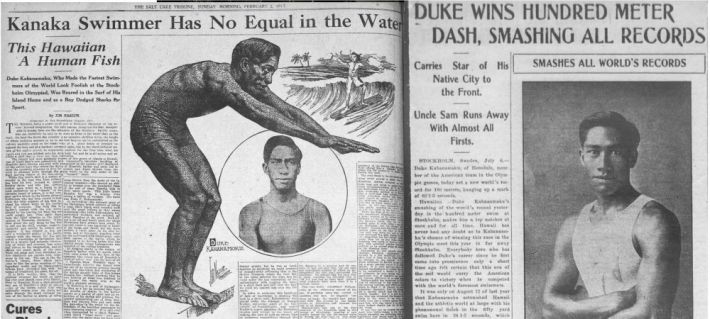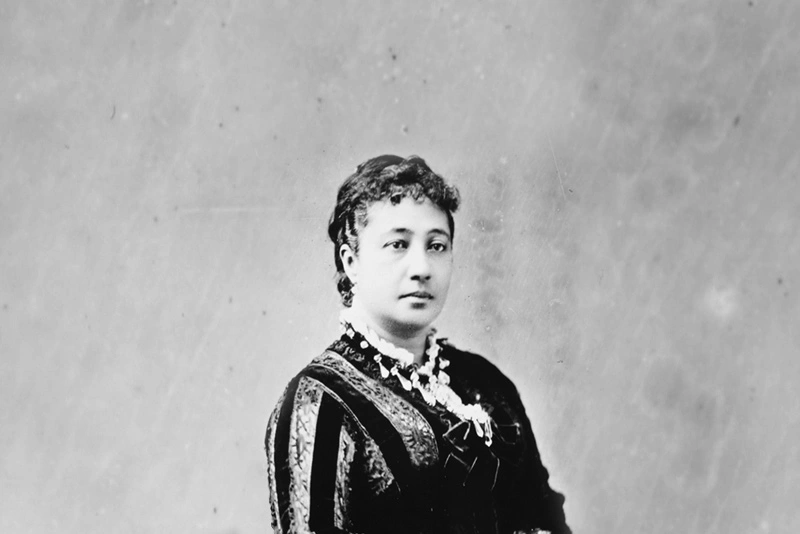The recently concluded Tokyo Summer Olympic games illustrated resiliency, excellence, and unity, highlighting our common humanity in the face of the global pandemic. When the world thinks of an Olympian, it envisions someone who is focused, hard-working, and talented; someone who exhibits qualities of excellence and fortitude.
Our own shores produce world-class watermen and waterwomen, including Olympian Carissa Moore! It’s fitting that a daughter of Hawaiʻi won the first-ever gold medal for surfing, which was introduced as a new Olympic sport this summer. Having surfing on the Olympic stage was the dream of another of Hawaiʻi’s own; in honor of his August 24 birthday, we celebrate the renown Hawaiian Olympian, Duke Kahanamoku!
Duke Paoa Kahinu Mokoe Hulikohola Kahanamoku was born on August 24, 1890. The Kingdom of Hawaiʻi was suffering the dramatic loss of life due to measles, bubonic plague, and leprosy epidemics, amid a global pandemic of influenza that killed about one million people worldwide.
Kahanamoku was two years old when Queen Liliʻuokalani was usurped in a bloodless coup and three years old when Hawaiʻi became a Republic on July 4, 1894. He was nine years old when Hawaiʻi was incorporated as a territory of the United States on April 30, 1900. Another global influenza pandemic would strike in 1918.
Under the Territory of Hawaiʻi, Duke Kahanamoku would go on to win Olympic fame for the United States from 1912 to 1920 in the sport of swimming. He was still able to compete with the best in the 1924 Olympics. Living through times of devastating losses of life and great change, Kahanamoku embodied the vitality of the Hawaiian people and what it meant to live with aloha.
Duke Kahanamoku’s family had a close association with the chiefly circles of Kamehameha ʻEkahi, and they had the familial privilege of being the designated kahu of some of the aliʻi’s most prized lands of Waikīkī. His father, Duke Halapu Kahanamoku, was a policeman with an interesting connection to our founder, Princess Bernice Pauahi Bishop. Beloved Hawaiian historian Mary Kawena Pukui recorded notes about this particular naming:
“The Duke of Edinburgh came sometime during the reign of Kamehameha V, Lot Kapuaiwa. (The Duke of Edinburgh arrived in Hawaiʻi on July 21, 1869). He was well entertained by royalty here. Among those close to Bernice Bishop was a man named Kahanamoku and his wife. It so happened that a son was born to them then and, to commemorate the visit of the Duke, Bernice Bishop named the baby Duke in honor of Prince Alfred. The famous swimmer, Duke Kahanamoku, is the oldest son of the Duke named by Bernice Pauahi Bishop.”
Duke’s mother, Julia Paʻakonia Lonokahikina Paoa, descended from the ʻĪ and Mahi families of Hawaiʻi Island. She was steadfast in her Christian faith and dedicated her life participating in charitable activities and organizations that helped others, particularly in healthcare. During WWI, she was a pivotal leader of the Red Cross (ʻAhahui Keʻa ʻUlaʻula) in Honolulu; she was a member of the Kapiʻolani Maternity Association and the Daughters of Hawaiʻi. She was a member of the Kaʻahumanu Society (ʻAhahui Kaʻahumanu), co-founded by our own Ke Aliʻi Pauahi. She and other Society members helped to care for families who had suffered the loss of family members as a result of foreign disease.
Born and raised on the shores of Kālia, Oʻahu (in the general vicinity of the Hilton Hawaiian Village near the intersection of Ena and Kālia Roads), Duke had a natural affinity for the water and was blessed with raw talent. His parents taught him the values of aloha by example, exemplifying servant leadership and a communal spirit. It is no wonder that “The Duke” was destined for such an amazing life. He attended Waikīkī Grammar School, Kamehameha School for Boys (where he was on the championship soccer team) and Mckinley High School.
In 1908, Duke Kahanamoku, along with his water-loving friends, Knute Cottrell and Ken Winter, formed Hawaiʻi’s very first surf club, Hui Nalu. In 1912 at 21 years of age, Kahanamoku easily qualified for the U.S. Olympic swimming team. At the Olympics in Stockholm, he won a gold medal in the 100-meter freestyle, and a silver medal with the second-place U.S. team in the men's 4×200-meter freestyle relay; the first Olympic medals won by a Hawaiian.
His Olympic career continued, and during the 1920 Olympics in Antwerp, Kahanamoku won gold medals in the 100 meters, bettering fellow Hawaiian Olympian Pua Kealoha, and in the relay. He finished the 100 meters with a silver medal during the 1924 Olympics in Paris, with the gold going to Johnny Weissmuller (of “Tarzan” fame who became a lifelong friend of Duke’s), and the bronze to Kahanamoku's brother, Samuel. This would be his final Olympic medal, but he served as an alternate for the U.S. water polo team at the 1932 Summer Olympics, qualifying to compete for four consecutive Olympic games a rare feat even today!
The only thing greater than Duke Kahanamoku’s phenomenal abilities as a waterman was his generous humanitarian spirit. By 1925, Kahanamoku was living in Newport Beach, California. On June 14 a vessel at Corona Del Mar trying to enter the city’s harbor capsized in heavy surf. Kahanamoku and a few other surfers paddled out to try and help. Using his wooden surfboard in the rough waters, Kahanamoku made repeated trips from shore to the capsized ship, saving eight people from drowning. Two other surfers were able to save four more individuals. The Newport Beach police chief called Kahanamoku's efforts, “The most superhuman surfboard rescue act the world has ever seen.” Kahanamoku’s use of a surfboard during this rescue led to lifeguards across the United States using surfboards as standard equipment for water rescues.
When he returned to Hawaiʻi a few years later, Kahanamoku was elected to serve as the Sheriff of Honolulu from 1932 to 1961, serving for 13 consecutive terms. Kahanamoku then served as the city’s “official greeter” for visitors to Hawaiʻi. Kahanamoku’s iconic career as the world’s most famous waterman was honored and memorialized when he became the first person to be inducted into both the Swimming Hall of Fame and the Surfing Hall of Fame. Recorded as having had the world’s longest surfboard ride in history – across the currents of Kalehuawehe in Waikīkī – he became known as the “father of modern surfing” and is responsible for popularizing the sport around the world.
In addition to his iconic statue in Waikīkī, there are also monuments in his honor at the Duke Kahanamoku Park at Freshwater Beach in Australia, and at Huntington Beach, California. It is no surprise that “The DUKE” is also an inductee of the U.S. Olympic Hall of Fame! As an ambassador of Hawaiʻi and true aloha, Duke Kahanamoku’s achievements continue to be points of pride and inspiration for athletes and the people of Hawaiʻi.
As Hawaiʻi’s “Ambassador of Aloha,” Duke shared his personal philosophy of life in a statement that says it all – it is known today by many as Duke’s Creed of Aloha:
“In Hawaiʻi we greet friends, loved ones or strangers with aloha, which means with love. Aloha is the key word to the universal spirit of real hospitality, which make Hawaiʻi renowned as the world's center of understanding and fellowship. Try meeting or leaving people with aloha. You'll be surprised by their reaction. I believe it and it is my creed. Aloha to you, Duke Paoa Kahanamoku.”

Newspaper clippings featuring Duke Kahanamoku (Left, Salt Lake Tribune, Feb. 2, 1913; right, reprinted from original in Honolulu Advertiser, Dec. 31, 1999)

Left: Duke Kahanamoku in the 1930s at Waikīkī Beach. The emblem under DUKE on the board is that of Hui Nalu, the very first surf club to exist in Hawaiʻi. This surfboard is now in the collections at the Bernice Pauahi Bishop Museum. Right: Duke Kahanamoku, Hawai‘i’s “Ambassador of Aloha.”
TAGS
hoʻokahua,kūkahekahe,cultural conversations
CATEGORIES
Kaipuolono Article, Regions, Themes, Culture, Community, Hawaii Newsroom, KS Hawaii Home, Kapalama Newsroom, Kapalama Home, Maui Newsroom, KS Maui Home, Newsroom, Campus Programs, Hawaii, Kapalama, Maui, Department News
Print with photos
Print text only










